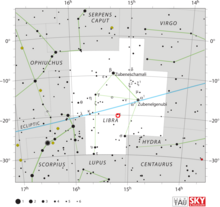K2-315b
| Discovery[1] | |
|---|---|
| Discovered by | Kepler (K2) |
| Discovery date | 2020 |
| Transit | |
| Orbital characteristics[1] | |
| 0.02±0.00 AU | |
| 3.14±0.00 d | |
| Inclination | 88.7°±0.2° |
| Physical characteristics | |
| 0.95±0.06 R🜨[1] | |
| Mass | 0.81 M🜨[2] |
| Temperature | 460 ± 5 K (368.33 ± 9.00 °F; 186.85 ± 5.00 °C)[1] |
K2-315b is an exoplanet located 185.3 light years away from Earth in the southern zodiac constellation Libra.[3][4] It orbits the red dwarf K2-315.
Discovery
[edit]K2-315b was discovered in 2020 by astronomers in an observatory using the Kepler space telescope.[1] It is also nicknamed the "Pi Earth" because it takes approximately 3.14 days to orbit the host star.[5]
Physical properties
[edit]The planet is thought to be a small rocky planet, even though composition is unknown.[5] Since it orbits very close to its star, it is too hot to host life, due to it having a scorching temperature of 450 K. Not much is known about it because it was just discovered, but it is similar to Earth, having a radius 95% that of Earth,[6] very similar to Venus, but has 81% Earth's mass.[2]

Host star
[edit]| Observation data Epoch J2000.0 Equinox J2000.0 (ICRS) | |
|---|---|
| Constellation | Libra[7] |
| Right ascension | 15h 12m 05.1944s[8] |
| Declination | −20° 06′ 30.5428″[8] |
| Apparent magnitude (V) | 17.67[9] |
| Characteristics | |
| Evolutionary stage | Red dwarf |
| Spectral type | M3.5±0.5 V[10] |
| Astrometry | |
| Radial velocity (Rv) | 6.25±0.17[10] km/s |
| Proper motion (μ) | RA: −120.013 mas/yr[8] Dec.: +74.471 mas/yr[8] |
| Parallax (π) | 17.6353 ± 0.0492 mas[8] |
| Distance | 184.9 ± 0.5 ly (56.7 ± 0.2 pc) |
| Details[10] | |
| Mass | 0.174±0.004 M☉ |
| Radius | 0.2±0.01 R☉ |
| Luminosity | 0.398% L☉ |
| Surface gravity (log g) | 5.094±0.006 cgs |
| Temperature | 3,300±30 K |
| Metallicity [Fe/H] | −0.24±0.09 dex |
| Rotational velocity (v sin i) | <5 km/s |
| Age | >1 Gyr |
| Other designations | |
| Database references | |
| SIMBAD | data |
K2-315 is a star in the southern zodiac constellation Libra.[11] It has an apparent magnitude of 17.67,[9] requiring a powerful telescope to be seen. The star is relatively close at a distance of 185 light years[8] but is receding with a radial velocity of 6.25 km/s.[10]
K2-315 has a stellar classification of M3.5±0.5 V, indicating that it is a M-type main-sequence star (with 14% uncertainty).[10] It has 17.4% the mass of the Sun and 20% its radius.[10] Typical for red dwarves, it has a luminosity less than 1% of the Sun, which yields an effective temperature of 3,300 K.[10] Unlike most planetary hosts, K2-315 is metal-deficient, with an iron abundance only 57% that of the Sun.[10] It is estimated to be over a billion years old, and has a projected rotational velocity less than 5 km/s.[10]
References
[edit]- ^ a b c d e Niraula, Prajwal; Julien de Wit; Rackham, Benjamin V.; Ducrot, Elsa; Burdanov, Artem; Crossfield, Ian J. M.; Valerie Van Grootel; Murray, Catriona; Garcia, Lionel J.; Alonso, Roi; Beard, Corey; Yilen Gomez Maqueo Chew; Delrez, Laetitia; Demory, Brice-Olivier; Fulton, Benjamin J.; Gillon, Michael; Gunther, Maximilian N.; Howard, Andrew W.; Issacson, Howard; Jehin, Emmanuel; Pedersen, Peter P.; Pozuelos, Francisco J.; Queloz, Didier; Rebolo-Lopez, Rafael; Sairam, Lalitha; Sebastian, Daniel; Thompson, Samantha; Triaud, Amaury H. M. J. (2020). "Π Earth: A 3.14 day Earth-sized Planet from K2's Kitchen Served Warm by the SPECULOOS Team". The Astronomical Journal. 160 (4): 172. arXiv:2006.07308. Bibcode:2020AJ....160..172N. doi:10.3847/1538-3881/aba95f. S2CID 219635862.
- ^ a b "Eyes On Exoplanets – Exoplanet Exploration: Planets Beyond our Solar System". exoplanets.nasa.gov. Retrieved 2021-08-08.
- ^ "Exoplanet-catalog". Exoplanet Exploration: Planets Beyond our Solar System. NASA. Retrieved 2020-10-22.
- ^ September 2020, Mike Wall 22 (22 September 2020). "'Pi planet' alien world takes 3.14 days to orbit its star". Space.com. Retrieved 2020-10-22.
{{cite web}}: CS1 maint: numeric names: authors list (link) - ^ a b Starr, Michelle (22 September 2020). "Astronomers Discover "Pi Earth" Exoplanet Orbits Its Star Once Every 3.14 Days". ScienceAlert. Retrieved 2020-10-21.
- ^ "Exoplanet Archive". exoplanetarchive.ipac.caltech.edu. Retrieved 2020-10-21.
- ^ "Find the constellation which contains given sky coordinates". djm.cc.
- ^ a b c d e Brown, A. G. A.; et al. (Gaia collaboration) (2021). "Gaia Early Data Release 3: Summary of the contents and survey properties". Astronomy & Astrophysics. 649: A1. arXiv:2012.01533. Bibcode:2021A&A...649A...1G. doi:10.1051/0004-6361/202039657. S2CID 227254300. (Erratum: doi:10.1051/0004-6361/202039657e). Gaia EDR3 record for this source at VizieR.
- ^ a b Muirhead, Philip S.; Dressing, Courtney D.; Mann, Andrew W.; Rojas-Ayala, Bárbara; Lépine, Sébastien; Paegert, Martin; De Lee, Nathan; Oelkers, Ryan (4 April 2018). "A Catalog of Cool Dwarf Targets for the Transiting Exoplanet Survey Satellite". The Astronomical Journal. 155 (4): 180. arXiv:1710.00193. Bibcode:2018AJ....155..180M. doi:10.3847/1538-3881/aab710. eISSN 1538-3881.
- ^ a b c d e f g h i Niraula, Prajwal; et al. (21 September 2020). "π Earth: A 3.14 day Earth-sized Planet from K2's Kitchen Served Warm by the SPECULOOS Team". The Astronomical Journal. 160 (4): 172. arXiv:2006.07308. Bibcode:2020AJ....160..172N. doi:10.3847/1538-3881/aba95f. eISSN 1538-3881. ISSN 0004-6256.
- ^ "Odkryto "Ziemię Pi". Okrąża swoją gwiazdę raz na 3,14 dnia". www.national-geographic.pl.




